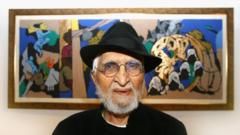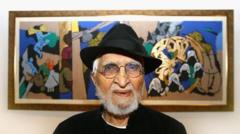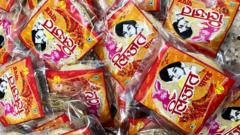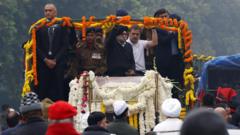A long-forgotten mural by MF Husain, titled "Untitled (Gram Yatra)," sold for a staggering $13.8 million at a recent Christie's auction. The piece reflects Indian village life through vivid interpretations and has been praised as a defining element of modern South Asian art.
MF Husain’s Rediscovered Masterpiece Breaks Records in New York Auction
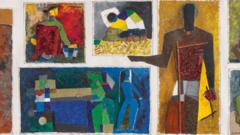
MF Husain’s Rediscovered Masterpiece Breaks Records in New York Auction
A newfound painting by Indian modernist MF Husain not only makes history but also highlights the cultural richness of Indian art.
A long-lost masterpiece by renowned Indian artist MF Husain has emerged from obscurity to redefine Indian art history after fetching an astonishing $13.8 million (£10.6 million) at a Christie's auction in New York last week. The painting, titled Untitled (Gram Yatra), is a large mural measuring 14 feet and provides a vibrant depiction of Indian village life. This sale eclipses the prior record of $7.4 million (£5.7 million) set by Amrita Sher-Gil's The Story Teller just this year.
MF Husain, an influential figure in Indian modernism who passed away in 2011, has long inspired generations of artists. In 2006, he left India amid threats from extremist groups unhappy with his artistic interpretations of spiritual figures.
The remarkable mural, painted in 1954, remained hidden in plain sight at a Norwegian hospital for nearly five decades. The work features 13 framed vignettes of daily village activities; scenes displaying women's roles—from cooking to caring for their children—contain vibrant earthly tones that echo the traditions of India's rich artistic heritage. One poignant frame even portrays a farmer extending his arm across two images, symbolizing a deep link to India's agrarian society.
Nishad Avari, the head of South Asian Modern and Contemporary Art at Christie's, remarks that Gram Yatra embodies the essence of modern South Asian art. He also notes the influence of Husain's international travels, especially his visit to China in 1952, which can be seen in the brushwork of the piece.
Husain’s artistic journey was rooted in his native land, drawing inspiration from the villages of India, paralleling Mahatma Gandhi's belief in the importance of rural life as the heart of the nation. Akhilesh, Husain's biographer, emphasizes how the artist's profound connection to Indian culture shaped the national narrative, reflecting the realities of everyday life.
The painted mural showcases the early evolution of Husain's unique style, incorporating modified cubist elements characterized by bold lines and geometric shapes. Its pathway from Delhi to Norway adds an intriguing narrative element to its sale. Originally purchased by Ukrainian doctor Leon Elias Volodarsky for a mere $295 while on a World Health Organization (WHO) mission, the painting adorned the Oslo University Hospital's walls, remaining largely unnoticed until its rediscovery in 2013—two years after Husain’s death.
Art expert Ashish Anand from Delhi Art Gallery anticipates that this historic sale will enhance the perception of Husain's work, broadening the appreciation of Indian art not just for its artistic merit but also as a valuable financial asset.




